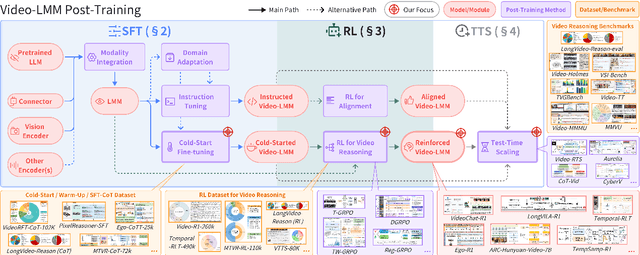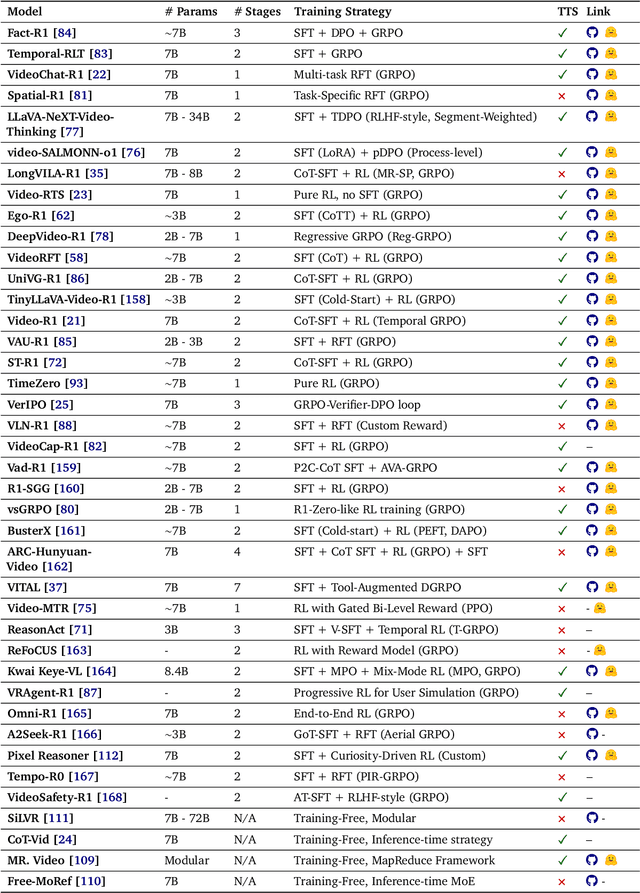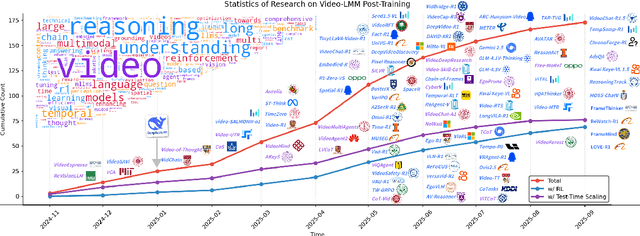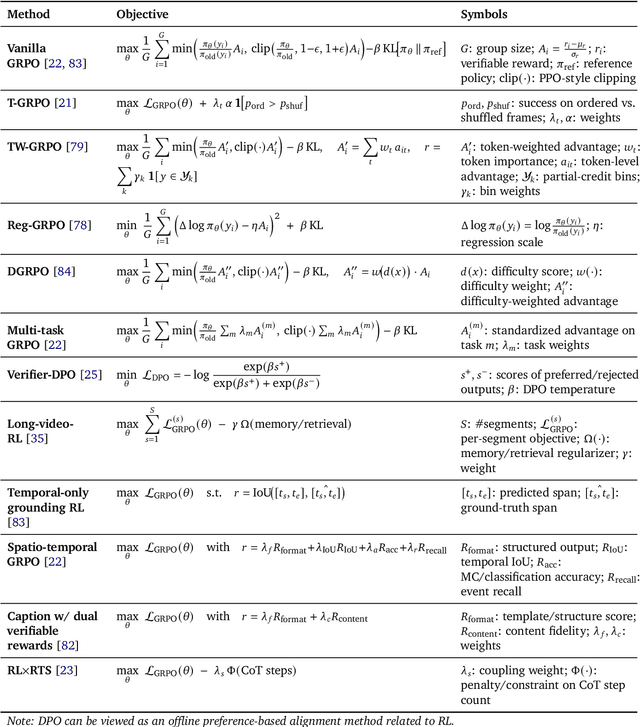Pinxin Liu
Video-LMM Post-Training: A Deep Dive into Video Reasoning with Large Multimodal Models
Oct 06, 2025



Abstract:Video understanding represents the most challenging frontier in computer vision, requiring models to reason about complex spatiotemporal relationships, long-term dependencies, and multimodal evidence. The recent emergence of Video-Large Multimodal Models (Video-LMMs), which integrate visual encoders with powerful decoder-based language models, has demonstrated remarkable capabilities in video understanding tasks. However, the critical phase that transforms these models from basic perception systems into sophisticated reasoning engines, post-training, remains fragmented across the literature. This survey provides the first comprehensive examination of post-training methodologies for Video-LMMs, encompassing three fundamental pillars: supervised fine-tuning (SFT) with chain-of-thought, reinforcement learning (RL) from verifiable objectives, and test-time scaling (TTS) through enhanced inference computation. We present a structured taxonomy that clarifies the roles, interconnections, and video-specific adaptations of these techniques, addressing unique challenges such as temporal localization, spatiotemporal grounding, long video efficiency, and multimodal evidence integration. Through systematic analysis of representative methods, we synthesize key design principles, insights, and evaluation protocols while identifying critical open challenges in reward design, scalability, and cost-performance optimization. We further curate essential benchmarks, datasets, and metrics to facilitate rigorous assessment of post-training effectiveness. This survey aims to provide researchers and practitioners with a unified framework for advancing Video-LMM capabilities. Additional resources and updates are maintained at: https://github.com/yunlong10/Awesome-Video-LMM-Post-Training
Can Sound Replace Vision in LLaVA With Token Substitution?
Jun 12, 2025Abstract:While multimodal systems have achieved impressive advances, they typically rely on text-aligned representations rather than directly integrating audio and visual inputs. This reliance can limit the use of acoustic information in tasks requiring nuanced audio understanding. In response, SoundCLIP explores direct audio-visual integration within multimodal large language models (MLLMs) by substituting CLIP's visual tokens with audio representations and selecting sound-relevant patch tokens in models such as LLaVA. We investigate two configurations: (1) projecting audio features into CLIP's visual manifold via a multilayer perceptron trained with InfoNCE on paired audio-video segments, and (2) preserving raw audio embeddings with minimal dimensional adjustments. Experiments with five state-of-the-art audio encoders reveal a fundamental trade-off. While audio-to-video retrieval performance increases dramatically (up to 44 percentage points in Top-1 accuracy) when audio is projected into CLIP's space, text generation quality declines. Encoders pre-trained with text supervision (CLAP, Whisper, ImageBind) maintain stronger generative capabilities than those focused primarily on audiovisual alignment (Wav2CLIP, AudioCLIP), highlighting the value of language exposure for generation tasks. We introduce WhisperCLIP, an architecture that fuses intermediate representations from Whisper, as well as AudioVisual Event Evaluation (AVE-2), a dataset of 580,147 three-second audiovisual clips with fine-grained alignment annotations. Our findings challenge the assumption that stronger cross-modal alignment necessarily benefits all multimodal tasks; instead, a Pareto frontier emerges wherein optimal performance depends on balancing retrieval accuracy with text generation quality. Codes and datasets: https://github.com/ali-vosoughi/SoundCLIP.
MMPerspective: Do MLLMs Understand Perspective? A Comprehensive Benchmark for Perspective Perception, Reasoning, and Robustness
May 26, 2025Abstract:Understanding perspective is fundamental to human visual perception, yet the extent to which multimodal large language models (MLLMs) internalize perspective geometry remains unclear. We introduce MMPerspective, the first benchmark specifically designed to systematically evaluate MLLMs' understanding of perspective through 10 carefully crafted tasks across three complementary dimensions: Perspective Perception, Reasoning, and Robustness. Our benchmark comprises 2,711 real-world and synthetic image instances with 5,083 question-answer pairs that probe key capabilities, such as vanishing point perception and counting, perspective type reasoning, line relationship understanding in 3D space, invariance to perspective-preserving transformations, etc. Through a comprehensive evaluation of 43 state-of-the-art MLLMs, we uncover significant limitations: while models demonstrate competence on surface-level perceptual tasks, they struggle with compositional reasoning and maintaining spatial consistency under perturbations. Our analysis further reveals intriguing patterns between model architecture, scale, and perspective capabilities, highlighting both robustness bottlenecks and the benefits of chain-of-thought prompting. MMPerspective establishes a valuable testbed for diagnosing and advancing spatial understanding in vision-language systems. Resources available at: https://yunlong10.github.io/MMPerspective/
$I^2G$: Generating Instructional Illustrations via Text-Conditioned Diffusion
May 22, 2025



Abstract:The effective communication of procedural knowledge remains a significant challenge in natural language processing (NLP), as purely textual instructions often fail to convey complex physical actions and spatial relationships. We address this limitation by proposing a language-driven framework that translates procedural text into coherent visual instructions. Our approach models the linguistic structure of instructional content by decomposing it into goal statements and sequential steps, then conditioning visual generation on these linguistic elements. We introduce three key innovations: (1) a constituency parser-based text encoding mechanism that preserves semantic completeness even with lengthy instructions, (2) a pairwise discourse coherence model that maintains consistency across instruction sequences, and (3) a novel evaluation protocol specifically designed for procedural language-to-image alignment. Our experiments across three instructional datasets (HTStep, CaptainCook4D, and WikiAll) demonstrate that our method significantly outperforms existing baselines in generating visuals that accurately reflect the linguistic content and sequential nature of instructions. This work contributes to the growing body of research on grounding procedural language in visual content, with applications spanning education, task guidance, and multimodal language understanding.
Intentional Gesture: Deliver Your Intentions with Gestures for Speech
May 21, 2025Abstract:When humans speak, gestures help convey communicative intentions, such as adding emphasis or describing concepts. However, current co-speech gesture generation methods rely solely on superficial linguistic cues (\textit{e.g.} speech audio or text transcripts), neglecting to understand and leverage the communicative intention that underpins human gestures. This results in outputs that are rhythmically synchronized with speech but are semantically shallow. To address this gap, we introduce \textbf{Intentional-Gesture}, a novel framework that casts gesture generation as an intention-reasoning task grounded in high-level communicative functions. % First, we curate the \textbf{InG} dataset by augmenting BEAT-2 with gesture-intention annotations (\textit{i.e.}, text sentences summarizing intentions), which are automatically annotated using large vision-language models. Next, we introduce the \textbf{Intentional Gesture Motion Tokenizer} to leverage these intention annotations. It injects high-level communicative functions (\textit{e.g.}, intentions) into tokenized motion representations to enable intention-aware gesture synthesis that are both temporally aligned and semantically meaningful, achieving new state-of-the-art performance on the BEAT-2 benchmark. Our framework offers a modular foundation for expressive gesture generation in digital humans and embodied AI. Project Page: https://andypinxinliu.github.io/Intentional-Gesture
The Tenth NTIRE 2025 Efficient Super-Resolution Challenge Report
Apr 14, 2025Abstract:This paper presents a comprehensive review of the NTIRE 2025 Challenge on Single-Image Efficient Super-Resolution (ESR). The challenge aimed to advance the development of deep models that optimize key computational metrics, i.e., runtime, parameters, and FLOPs, while achieving a PSNR of at least 26.90 dB on the $\operatorname{DIV2K\_LSDIR\_valid}$ dataset and 26.99 dB on the $\operatorname{DIV2K\_LSDIR\_test}$ dataset. A robust participation saw \textbf{244} registered entrants, with \textbf{43} teams submitting valid entries. This report meticulously analyzes these methods and results, emphasizing groundbreaking advancements in state-of-the-art single-image ESR techniques. The analysis highlights innovative approaches and establishes benchmarks for future research in the field.
Caption Anything in Video: Fine-grained Object-centric Captioning via Spatiotemporal Multimodal Prompting
Apr 09, 2025Abstract:We present CAT-V (Caption AnyThing in Video), a training-free framework for fine-grained object-centric video captioning that enables detailed descriptions of user-selected objects through time. CAT-V integrates three key components: a Segmenter based on SAMURAI for precise object segmentation across frames, a Temporal Analyzer powered by TRACE-Uni for accurate event boundary detection and temporal analysis, and a Captioner using InternVL-2.5 for generating detailed object-centric descriptions. Through spatiotemporal visual prompts and chain-of-thought reasoning, our framework generates detailed, temporally-aware descriptions of objects' attributes, actions, statuses, interactions, and environmental contexts without requiring additional training data. CAT-V supports flexible user interactions through various visual prompts (points, bounding boxes, and irregular regions) and maintains temporal sensitivity by tracking object states and interactions across different time segments. Our approach addresses limitations of existing video captioning methods, which either produce overly abstract descriptions or lack object-level precision, enabling fine-grained, object-specific descriptions while maintaining temporal coherence and spatial accuracy. The GitHub repository for this project is available at https://github.com/yunlong10/CAT-V
Why Reasoning Matters? A Survey of Advancements in Multimodal Reasoning (v1)
Apr 04, 2025



Abstract:Reasoning is central to human intelligence, enabling structured problem-solving across diverse tasks. Recent advances in large language models (LLMs) have greatly enhanced their reasoning abilities in arithmetic, commonsense, and symbolic domains. However, effectively extending these capabilities into multimodal contexts-where models must integrate both visual and textual inputs-continues to be a significant challenge. Multimodal reasoning introduces complexities, such as handling conflicting information across modalities, which require models to adopt advanced interpretative strategies. Addressing these challenges involves not only sophisticated algorithms but also robust methodologies for evaluating reasoning accuracy and coherence. This paper offers a concise yet insightful overview of reasoning techniques in both textual and multimodal LLMs. Through a thorough and up-to-date comparison, we clearly formulate core reasoning challenges and opportunities, highlighting practical methods for post-training optimization and test-time inference. Our work provides valuable insights and guidance, bridging theoretical frameworks and practical implementations, and sets clear directions for future research.
Contextual Gesture: Co-Speech Gesture Video Generation through Context-aware Gesture Representation
Feb 11, 2025Abstract:Co-speech gesture generation is crucial for creating lifelike avatars and enhancing human-computer interactions by synchronizing gestures with speech. Despite recent advancements, existing methods struggle with accurately identifying the rhythmic or semantic triggers from audio for generating contextualized gesture patterns and achieving pixel-level realism. To address these challenges, we introduce Contextual Gesture, a framework that improves co-speech gesture video generation through three innovative components: (1) a chronological speech-gesture alignment that temporally connects two modalities, (2) a contextualized gesture tokenization that incorporate speech context into motion pattern representation through distillation, and (3) a structure-aware refinement module that employs edge connection to link gesture keypoints to improve video generation. Our extensive experiments demonstrate that Contextual Gesture not only produces realistic and speech-aligned gesture videos but also supports long-sequence generation and video gesture editing applications, shown in Fig.1 Project Page: https://andypinxinliu.github.io/Contextual-Gesture/.
GestureLSM: Latent Shortcut based Co-Speech Gesture Generation with Spatial-Temporal Modeling
Jan 31, 2025



Abstract:Controlling human gestures based on speech signals presents a significant challenge in computer vision. While existing works did preliminary studies of generating holistic co-speech gesture from speech, the spatial interaction of each body region during the speech remains barely explored. This leads to wield body part interactions given the speech signal. Furthermore, the slow generation speed limits the construction of real-world digital avatars. To resolve these problems, we propose \textbf{GestureLSM}, a Latent Shortcut based approach for Co-Speech Gesture Generation with spatial-temporal modeling. We tokenize various body regions and explicitly model their interactions with spatial and temporal attention. To achieve real-time gesture generations, we exam the denoising patterns and design an effective time distribution to speed up sampling while improve the generation quality for shortcut model. Extensive quantitative and qualitative experiments demonstrate the effectiveness of GestureLSM, showcasing its potential for various applications in the development of digital humans and embodied agents. Project Page: https://andypinxinliu.github.io/GestureLSM
 Add to Chrome
Add to Chrome Add to Firefox
Add to Firefox Add to Edge
Add to Edge